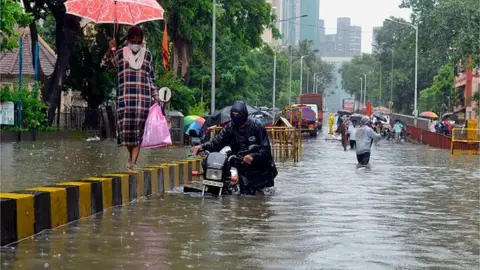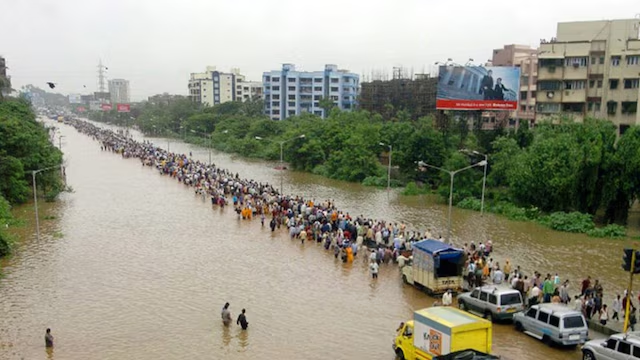
Mumbai, a city that never sleeps and thrives on its relentless pace, has recently found itself caught in an unexpected battle with nature as an early monsoon surge drenched the metropolis with heavy rainfall. This unseasonal downpour marks a departure from historical monsoon patterns, coming weeks ahead of the usual schedule. The Indian Meteorological Department (IMD) responded swiftly, issuing a yellow alert to prepare the public and municipal bodies for sustained heavy rains and the disruption they bring.
The heavy showers arrived with a suddenness that surprised many Mumbaikars, causing streets to flood, trains to slow down, and daily routines to be interrupted. The vibrant city, known for its ceaseless hustle, had to pause momentarily as waterlogging rendered some key roads impassable and commuters faced hours-long delays. From the iconic Marine Drive to the densely populated suburbs, the rain’s impact was both immediate and widespread.
This unexpected early monsoon is not just a meteorological curiosity but a signal of shifting climate patterns affecting not only Mumbai but the broader western coastal region of India. The city’s infrastructure, already strained during typical monsoon seasons, faced an immediate test, highlighting both the progress made in recent years and the persistent vulnerabilities that demand urgent attention.
As the rain continues to fall intermittently, the city is bracing for what meteorologists predict could be an intense monsoon season, with the yellow alert serving as an official warning to residents to prepare and stay vigilant. The atmosphere in Mumbai is charged with a mixture of awe at nature’s force and concern over the challenges it brings to daily life and urban management.
Meteorological Insights: Early Monsoon and Its Impact on Mumbai
The phenomenon of an early monsoon is not just a random event but the result of complex interactions between oceanic and atmospheric systems. Traditionally, the monsoon reaches Mumbai around the first week of June, marking the onset of a rainy season that transforms the city’s landscape. This year, however, the monsoon advanced, with heavy rains beginning to drench the city as early as late May.
Experts at the Indian Meteorological Department have linked this early onset to rising sea surface temperatures in the Arabian Sea, which have intensified the moisture flow towards India’s western coast. These warmer waters fuel stronger, moisture-rich winds that bring increased rainfall. Additionally, global climate change is believed to be playing a role by altering the timing and intensity of monsoon patterns across the subcontinent.
The IMD’s yellow alert reflects this complex scenario, indicating a need for caution without signaling an immediate severe crisis. It is a preparatory stage to alert city officials and the public about impending weather events that could lead to heavy rains, localized flooding, and associated hazards.
For Mumbai, which is geographically positioned as a coastal city with low-lying areas and natural drainage channels that often face blockages, early heavy rains pose a significant risk. Waterlogging during the monsoon is a perennial problem, and the city’s drainage infrastructure has historically struggled to keep pace with rapid urban growth.
This early arrival of the monsoon has important implications beyond weather alone. It affects transportation, public health, municipal services, and the economic rhythm of the city. It also raises questions about how climate variability might be reshaping weather cycles and what that means for future urban planning and disaster management in Mumbai.
Infrastructure Challenges Amid Mumbai’s Torrential Downpour
Mumbai’s infrastructure has long been tested by the annual monsoon, with some years leaving the city paralyzed by floods and waterlogging. This early monsoon episode is no exception. Despite years of investment in drainage systems, water pumping stations, and flood mitigation projects, the city’s infrastructure is still vulnerable, especially to an unusual early burst of rainfall.
The sudden heavy showers overwhelmed several drainage points, leading to rapid water accumulation on streets and in residential areas, especially those at lower elevations. Roads in areas like Bandra, Andheri, and parts of the city’s suburbs saw significant waterlogging, making commuting a nightmare for many residents.
Mumbai’s local trains, the lifeline of millions of daily commuters, were severely affected. Tracks submerged under water caused delays and cancellations, impacting the city’s economy and the livelihoods of thousands who depend on timely transport. In some locations, the water level rose so quickly that platforms became slippery and dangerous, raising safety concerns.
The Brihanmumbai Municipal Corporation (BMC) acted swiftly, deploying teams to clear clogged drains, monitor vulnerable flood-prone areas, and carry out emergency water pumping. Despite these efforts, the sheer volume of rainfall exposed gaps in the city’s preparedness, reinforcing the need for continual upgrades and smarter infrastructure solutions.
Experts have long warned that Mumbai’s rapid urbanization, with extensive concrete surfaces replacing natural soil and green cover, worsens flooding by reducing natural water absorption. The sprawling city also faces challenges in waste management, as garbage blocking drains is a key factor in water stagnation. This year’s early heavy rains brought these issues into sharp focus.
Urban planners emphasize that Mumbai’s vulnerability to monsoon floods is not just an engineering challenge but also a socio-economic issue. Many vulnerable communities live in low-lying, poorly serviced areas with limited access to emergency services. Flooding disrupts their lives disproportionately, affecting health, sanitation, and livelihoods.
Public Response and Safety Measures During the Yellow Alert
In response to the yellow alert issued by the IMD, both public institutions and private citizens in Mumbai have adopted a cautious approach to dealing with the rains. The alert serves as a formal signal to take precautions and prepare for ongoing heavy rainfall.
Schools and offices in Mumbai reacted by adjusting their schedules or shifting to remote work and online classes to reduce the risks posed by wet and hazardous conditions. Public transportation authorities increased their operational oversight, deploying additional staff at critical junctures and improving communication with passengers to manage expectations.
Healthcare facilities remained on heightened alert, anticipating a surge in waterborne illnesses that frequently accompany the monsoon season. Mumbai’s public health departments have been actively conducting awareness campaigns on hygiene, mosquito control, and disease prevention, urging residents to take preventive actions seriously.

Community organizations and NGOs have also stepped up efforts to assist vulnerable groups. Volunteers distributed essentials like drinking water and hygiene kits in flood-affected areas, helping those with limited resources cope with the adverse conditions.
The general public exhibited mixed reactions: while some welcomed the rains as a much-needed respite from the recent heatwave, others expressed frustration over disrupted commutes and the challenges of navigating waterlogged streets. Social media was abuzz with images and videos capturing everything from submerged roads to overflowing drains, reflecting the collective experience of the city grappling with early monsoon impacts.
Emergency helplines were publicized widely, ensuring that residents had access to quick assistance in case of urgent needs, such as evacuations or medical emergencies. This coordinated approach between government agencies, healthcare providers, and community groups played a crucial role in minimizing the adverse effects of the yellow alert situation.
Environmental and Economic Implications of Early Monsoon in Mumbai
The early and heavy monsoon rains in Mumbai carry significant environmental and economic ramifications. On the environmental front, the rains replenish groundwater reserves and reservoirs, which is critical for a city that frequently faces water shortages. However, the intensity and timing of the rainfall also heighten the risk of soil erosion and landslides in the nearby hill stations and suburbs that border the city.
Ecologists and climate scientists note that the early onset of monsoon rains could be indicative of broader climate shifts. These changes bring unpredictable weather patterns, complicating efforts to plan and prepare for monsoons. The variability also affects biodiversity in urban and peri-urban areas, where natural habitats are already under pressure from development.
From an economic perspective, the rains disrupt numerous sectors. Construction work, a major part of Mumbai’s economy, comes to a halt during heavy rainfall due to safety concerns and logistical challenges. Small businesses and street vendors face losses as foot traffic dwindles during wet weather.
Transport delays cascade into lost productivity for millions of workers who rely on Mumbai’s extensive public transit system. Additionally, the cost of emergency services and repair work escalates during and after heavy rains, putting further strain on municipal budgets.
The agricultural belts surrounding Mumbai, while benefiting from early rains, also face risks if the rainfall becomes erratic or excessively heavy. Crop damage can occur, impacting farmers’ incomes and food supply chains. This interplay of urban and rural impacts highlights the interconnectedness of Mumbai with its wider region.
Environmentalists stress the urgent need for integrated water management practices that balance urban development with conservation of natural water bodies and green spaces. Sustainable planning is vital to reduce flood risks and improve the city’s resilience against climate-induced weather extremes.
The Human Element: Stories from Mumbai’s Rain-Soaked Streets
Beyond data and forecasts, the impact of early monsoon rains is best understood through the lived experiences of Mumbai’s residents. Stories from the rain-soaked streets reveal the resilience, challenges, and everyday heroism that define the city during such times.
In neighborhoods prone to flooding, families scramble to protect their homes and belongings from rising water. Shopkeepers in busy markets secure their goods and navigate the difficult task of running businesses under wet, chaotic conditions. Commuters share tales of long waits at waterlogged bus stops and packed local trains struggling to operate safely.
At the same time, community spirit shines through as neighbors help each other move belongings to safer places and share resources. Volunteers wade through flooded lanes to distribute food and medical aid to those trapped or unable to venture out.
Emergency responders work round the clock, often in challenging conditions, to rescue stranded individuals and clear blockages. Their dedication highlights the human cost of natural disasters and the importance of preparedness and solidarity.
For many Mumbaikars, the monsoon is a season of contrasts — a mix of joy and hardship, renewal and disruption. The early arrival this year has intensified these emotions, reminding everyone of the city’s enduring relationship with the rains.
Preparing Mumbai for Future Monsoon Seasons
The early monsoon rains of 2025 serve as a crucial lesson for Mumbai’s policymakers, urban planners, and residents alike. The city must accelerate efforts to build resilience not only against this year’s weather challenges but also in anticipation of future climate variability.
Upgrading drainage systems, investing in flood mitigation infrastructure, and ensuring timely maintenance are essential steps. Beyond engineering, improving waste management to prevent drain blockages and increasing green spaces to enhance water absorption can significantly reduce flood risks.
Advanced weather forecasting and real-time communication systems will help authorities and citizens prepare better. Early warning systems need to be integrated with rapid response mechanisms to minimize damage and safeguard lives.
Urban development must be guided by sustainability principles that prioritize ecological balance and social equity. Protecting natural wetlands and conserving biodiversity can help buffer the city against extreme weather events.
Community engagement and awareness remain critical. Educating residents on safety measures, health precautions, and emergency protocols ensures that everyone plays a part in the city’s preparedness.
Mumbai’s experience this season is a call to action to rethink how the city interacts with its environment. Only through coordinated efforts between government, private sector, and citizens can Mumbai hope to face future monsoons with confidence and resilience.

